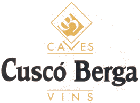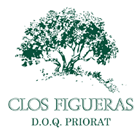PRADOREY
(An Online Virtual Visit)
by
Kathy and Terry Sullivan
Photos provided by Pradorey (unless otherwise noted).
This article describing Pradorey is based on the online interview, online data and photos supplied by Pradorey. Pradorey also graciously sent us five samples of wine. The article was written during the time of the world-wide 2020 pandemic. Fernando Rodríguez de Rivera Cremades, Managing Director for Pradorey and grandson of the founder, answered our questions.
Summary: Pradorey, a Spanish winery, is on historic land and close to the Duero River in the Ribera del Duero wine region. The winery offers a large selection of wines, many of which Tempranillo is a major component. Wine enthusiasts have different tour options and there is an inn for lodging.

History
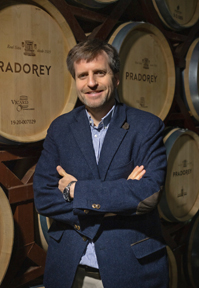 The winery dates the ownership of the land back to 1503 when the land was purchased by Queen Isabella of Castile. The Pradorey land is a Real Sitio. Fernando Rodríguez de Rivera Cremades (pictured right) wrote: A Real Sitio (Royal Site) is not something that you can name yourself, but rather a King has to give you that title. In this case, when Queen Isabel la Católica bought this farm in 1503, she granted it this distinction.
The winery dates the ownership of the land back to 1503 when the land was purchased by Queen Isabella of Castile. The Pradorey land is a Real Sitio. Fernando Rodríguez de Rivera Cremades (pictured right) wrote: A Real Sitio (Royal Site) is not something that you can name yourself, but rather a King has to give you that title. In this case, when Queen Isabel la Católica bought this farm in 1503, she granted it this distinction.
Over time renowned figures visited the property. In 1921 a large hydroelectric dam was built on the Duero River which traverses the large property. This hydroelectric dam continues to produce power.
Much later in 1989 Javier Cremades de Adaro an agronomist, purchased the land and began planting vineyards. According to Fernando Rodríguez de Rivera Cremades: They called him "the madman" from la Ventosilla, because you had to be mad to plant so many vineyards in the coldest part of the Ribera del Duero. You have to understand that today this region is a success story, but in the 80s it was a great unknown. And I think that a bit of my grandfather's madness has stuck to my brother and me, that we are the ones who are now in the daily life of the winery. When you visit the winery and see the room with clay amphoras or how we hand-tread grapes to make El Buen Alfarero, you realize that there is something in PRADOREY's DNA that is different from most of what is in the sector.
Today Pradorey is one of the largest estates in Northern Spain. Its largest vineyard is in Ribera del Duero. Fernando Rodríguez de Rivera Cremades wrote that Pradorey is one of the top 10 wineries that uses only its own grapes.
Vineyards
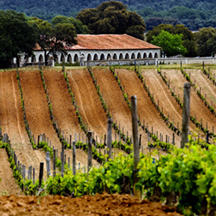 Pradorey owns and controls 545 hectares (1,347 acres) of total vineyards among nine vineyards with different terroirs. The vineyards have an elevation between 790 meters (2,592 feet) and 840 meters (2,756 feet). The El Hoyo Dornajo soils have little organic content, but a clay-loam texture with a high limestone content. La Mina also has poor organic content but a sandy loam texture with limestone. Prado del Rey (King’s Meadow) pictured left, has a high organic content with clay-loam texture near the top and sandy loam near the bottom. El Pino offers diverse soils that include clay loam, sandy loam and sandy soils.
Pradorey owns and controls 545 hectares (1,347 acres) of total vineyards among nine vineyards with different terroirs. The vineyards have an elevation between 790 meters (2,592 feet) and 840 meters (2,756 feet). The El Hoyo Dornajo soils have little organic content, but a clay-loam texture with a high limestone content. La Mina also has poor organic content but a sandy loam texture with limestone. Prado del Rey (King’s Meadow) pictured left, has a high organic content with clay-loam texture near the top and sandy loam near the bottom. El Pino offers diverse soils that include clay loam, sandy loam and sandy soils.
Los Robles has shallow clay loam soil. Valdelayegua offers two terrains close to the Duero and Gromejon Rivers. One area has sandy loam and the other area has a clay loam texture with limestone. Salgüero vineyard is smaller with 27 hectares and is now an organic vineyard. The soil is mostly sandy loam with some areas with clay and a high amount of limestone . La Recorba was planted in 2013. The soil is clayey and the bottom area is a shallow layer of rock with deeper soils underneath. Los Quemados was recently planted in 2020 and is at the highest altitude of all the vineyards at 820 meters to 840 meters.
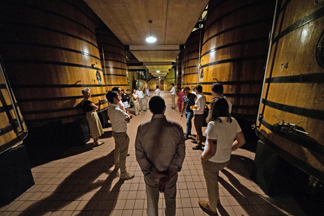 Winemaking
Winemaking
Currently Pradorey typically produces between 2.2 and 2.3 million bottles. The future for Pradorey is not to increase production but rather to concentrate on continuing to improve the quality of the wines. Pradorey is not interested in sourcing grapes or using bulk wines in their wine production. They believe in the quality of their own vineyard grapes.
The winemaker is Francisco Martin San Juan. Fernando Rodríguez de Rivera Cremades noted: He is passionate about his job, bold and very imaginative, unconventional and a tireless seeker of the limits of our terroir. Francisco is a winemaker with many “firsts.” Francisco was the first winemaker to produce a pale rosé in Ribera del Duero. Francisco also produced the first Ribera del Duero blanc the noir. He was the first Ribera del Duero winemaker to use centenary clay amphoras for fermenting and aging wines.
Tinaja Wine
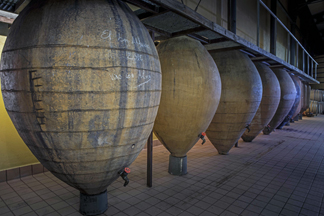 Tinaja are earthen vessels made from clay and fired. Winemakers have used earthen vessels to ferment grapes and macerate and age wines for millennia. The oldest earthen vessel that we have seen was a 6,000 year old qvevri at a winery museum in the Kakheti region of the country Georgia. Now, there is a return to ancient winemaking in earthen vessels around the world. Pradorey is experimenting with these clay vessels to see what can give the best expression of Tempranillo.
Tinaja are earthen vessels made from clay and fired. Winemakers have used earthen vessels to ferment grapes and macerate and age wines for millennia. The oldest earthen vessel that we have seen was a 6,000 year old qvevri at a winery museum in the Kakheti region of the country Georgia. Now, there is a return to ancient winemaking in earthen vessels around the world. Pradorey is experimenting with these clay vessels to see what can give the best expression of Tempranillo.
Pradorey unearthed several tinaja in Spain. They now stand above ground in a section of the winery. We were curious on how tinaja were treated before, during and after making wine.
Wine Trail Traveler: Do you coat the inside of your tinaja prior to making wine in them?
Fernando Rodríguez de Rivera Cremades: This is very interesting, because we wanted to see the impact of the oxygen in the wine through the pores of the clay. Once we noticed that the impact was huge, we decided to carry out a R&D project comparing different natural coatings (one of them was with beeswax) inside the tinaja with the raw one. What we saw is that, in the raw tinaja, the delivery of oxygen was bigger at the beginning. Once the pores were sealed, that delivery was very small. On the other side, those tinajas with coatings, delivered the oxygen in a more homogeneous way during the fermentation, as the pores needed more time to get sealed.
Which is better? It depends on what you are looking for with the tinaja. In terms of aging, using raw tinajas is much better, as the wine will evolve slower and better, but if you want to get the wine drinkable as soon as possible, then using coats is more interesting. However, we have to admit that we don´t know which would be the impact of using tinajas without coating if they were buried, as the exchange of oxygen would be completely different.
We also learned that cleaning tinajas is a challenge. The winemaking team at Pradorey have had success with ozone.
We asked about closing the opening of the tinajas.
Fernando Rodríguez de Rivera Cremades: The first time we elaborated wine in tinajas, we had some problems with the volatile, so what we did, was to bottle the wine a little bit earlier than expected when we started the vinification. That year we used a traditional cover made of wood. For the following vintages, we used a cover called in Spain “siempre llena” (always full). We paid much attention to shrinkages, refilling the tinajas with some other wine from the same plot which was in other tinajas. With these two things, we were able to control the volatile and to prevent oxidation.
Wines
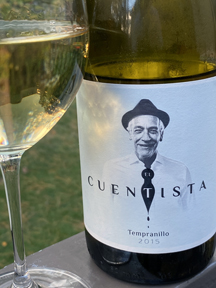 The 2015 El Cuentista (pictured left photo by Wine Trail Traveler) is a white Tempranillo (blanc de noir) the first to be crafted in the Ribera del Duero. The 13.5% alcohol wine had a light gold color. The aroma is reminiscent of a fruit salad. The crispy taste has an oak character; the wine spent nine months in American oak barrels. Juicy nectarines surround the oaky vanilla influence. This white wine has a medium/full body. The finish is fruit forward with the fruit yielding to mineral on the long aftertaste. We paired the wine with Manchego cheese and a chicken stew dinner.
The 2015 El Cuentista (pictured left photo by Wine Trail Traveler) is a white Tempranillo (blanc de noir) the first to be crafted in the Ribera del Duero. The 13.5% alcohol wine had a light gold color. The aroma is reminiscent of a fruit salad. The crispy taste has an oak character; the wine spent nine months in American oak barrels. Juicy nectarines surround the oaky vanilla influence. This white wine has a medium/full body. The finish is fruit forward with the fruit yielding to mineral on the long aftertaste. We paired the wine with Manchego cheese and a chicken stew dinner.
The 2015 Finca Valdelayegua, Ribera del Duero DDO (Denominación de Origen) was a single vineyard blend of Tempranillo with a splash of Cabernet Sauvignon and Merlot. The wine had a dark opaque ruby color with 14% alcohol. The aroma had black raspberries with a hint of earthiness. The taste included black raspberries, blackberries and baking spices. The wine had a medium/full body with moderate tannins. The finish is a blend of fruit and spices.
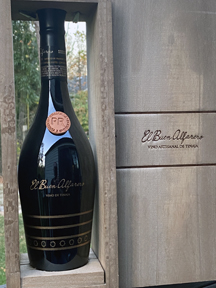 The 2016 Adaro, Ribera del Duero DDO has an opaque ruby color with a light ruby rim. This 100% Tempranillo has 14.5% alcohol. The wine has a very pleasant blend of black berry fruits and baking spices on the aroma. Blackberries and plum are upfront on the taste then yielded to baking spices. The wine had a full body with bold tannins. The fruity finish also yielded to baking spices
The 2016 Adaro, Ribera del Duero DDO has an opaque ruby color with a light ruby rim. This 100% Tempranillo has 14.5% alcohol. The wine has a very pleasant blend of black berry fruits and baking spices on the aroma. Blackberries and plum are upfront on the taste then yielded to baking spices. The wine had a full body with bold tannins. The fruity finish also yielded to baking spices
The 2014 Élite, Ribera del Duero DDO was a dark opaque garnet color with 15% alcohol. The aroma smelled expensive, reminiscent of a black fruit salad and spices. The taste included blackberries, black raspberries, plums and baking spices. The mouthfeel is velvety. This wine has a full body with bold tannins. The fruity and spicy finish is well blended.
The 2016 El Buen Alfareo, Ribera del Duero DDO (pictured right, photo by Wine Trail Traveler) came in a wood box. The name translates to “the good potter,” a reference to the wine spending some time in a tinaja. The bottle was sealed with a wax closure. The wine had a garnet color with a dark ruby rim. This 100% Tempranillo wine had black fruits on the aroma. The taste included blackberries, black raspberries, black plums and a hint of black cherries. This full-bodied wine had kissing tannins. The finish was fruity. This wine truly expressed the Tempranillo grape without the influence that oak imparts to a wine.
Wine Tourism
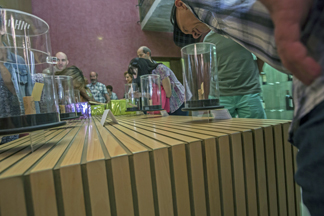 The winery offers visitors tours in both Spanish and English. Several ways to visit Pradorey include: booking a visit to the winery, visiting the underground winery, a culinary tour, or enjoying family wine tourism. Visits can be booked on Pradorey’s website.
The winery offers visitors tours in both Spanish and English. Several ways to visit Pradorey include: booking a visit to the winery, visiting the underground winery, a culinary tour, or enjoying family wine tourism. Visits can be booked on Pradorey’s website.
The typical tour to Pradorey includes learning about red and rose winemaking. This visit includes a guided tasting of two wines with Iberian charcuterie, gourmet cheese and Pradorey olive oil.
The Underground Winery tour includes one night's lodging, a meal at the Posada, a tasting of two of Pradorey's wines with charcuterie, gourmet cheese and olive oil.
The Culinary Tour includes the above tasting of two wines, Iberian charcuterie, gourmet cheese and Pradorey olive oil and a meal at La Posada.
The Family Wine Tour includes one night's lodging in a double room, a dinner at the Posada, a tour of dairy and calf farm, a winery tour including two wines and Iberian characuterie with gourmet cheese and Pradorey olive oil.
The Royal Inn
The Royal Inn at Pradorey dates back to the 17th century. The Inn was built by the Duke of Lerma. The King visited here along with his guests. The style of the palace is Herrerian. The exterior remans the same as originally built.
Carretera CL – 619 km 66 ,09443
Gumiel de Mercado (Burgos)
España
Article written November 2020.
Please support the following.
 |
|||
 |
 |

